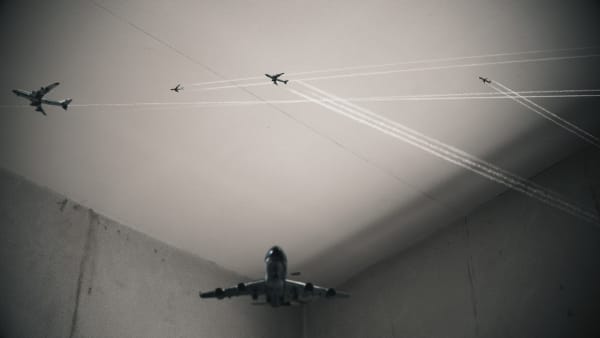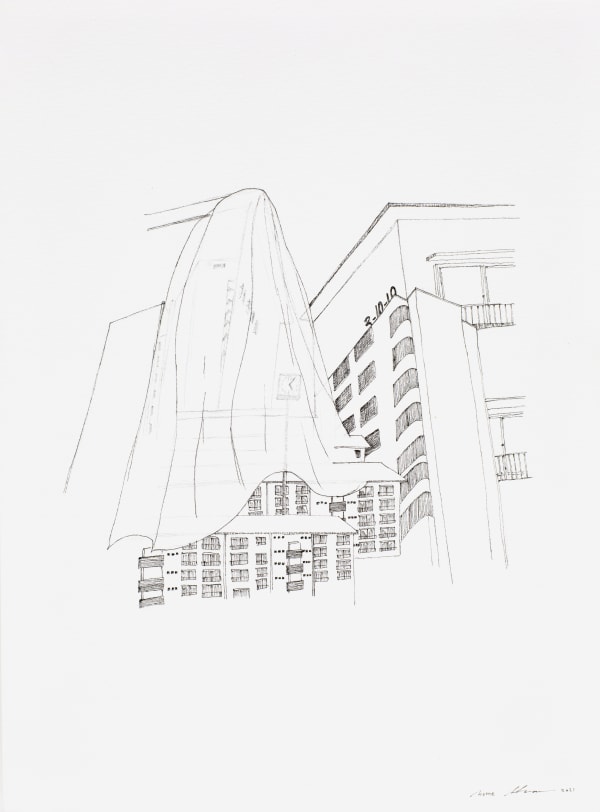-
 Hiraki Sawa, Courtesy of Ota Fine Arts
Hiraki Sawa, Courtesy of Ota Fine Arts -
In Ota Fine Arts Tokyo’s recent exhibition “/home” (until 3rd April) and Ota Fine Arts Shanghai’s exhibition “Hiraki Sawa and SHINCHIKA” (until 30th April), Hiraki Sawa presents his latest video work “/home” together with series of drawings. In view of these recent exhibitions, we had a conversation with Sawa about his creative process and experiences.
To find out more about the exhibition “/home”, click here, and for “Hiraki Sawa and SHINCHIKA”, click here.
-
Hiraki Sawa: Artist Interview
-
― Could you tell us more about how the video work /home came about?
After making my debut video work “dwelling” (2002) about 20 years ago, I have tried several times to make another work involving airplanes flying indoors, but had not achieved results that I was satisfied with. Meanwhile, the house where I grew up in had to be vacated in 2017, so I decided to keep a record of the house in a video. Now, about 20 years after making “dwelling”, I came back to the motif of the airplane that I made in my room in London in 2002, and juxtaposed it in the video of my childhood home. This was the first trigger. “/home” is a piece that combines my childhood memories with the airplane motif that kickstarted my career as an artist. It is not exactly the same as “dwelling”, but I created the work with a sense of tracing the space with the trajectory and route of airplanes while remembering the structure of the house.
― During your creation, do you feel like you are immersed in your memories, or do you feel excitement?
Fundamentally speaking, when I make an artwork and get excited, it is a similar feeling to a child playing with toys with imagination. I forget about the time and create works in these moments. It is said that children around the age of 5 are good at drawing. I find importance in how I could be like a child in terms of my imagination and my consciousness when I am expressing these through my works. It is not to imitate a child, but to be a child when creating the work. This is what I value in an expression. Looking at drawings my daughter made when she was little, it comes as a surprise that I will never be able to draw with such usage of colours and compositions. After making artworks for almost 20 years, I find it exciting when my brain works like a child playing.
-
-
- Could you explain more about ‘illusory new town’?
Living in a new residential area known as a new town was natural for me. Before the experience of losing the home that I grew up in, I had fixed views about the idea of a house, a family, and the society. I thought it would be sad or a little lonely to lose our home. But from a historical point of view, neither my home, nor the new residential area exists. A new residential area is a very modern illusion, and such a system is designed by humans only recently. I have a friend who talks about a festival all the time, and that festival has been going on for about 1,500 years. In contrast to this, the neighborhood association festival that I used to go to when I was a child is probably less than a hundred years old. This means that the festival he was talking about and the festival that came to my mind are two different things. This brought about the feeling that what I had believed one thing to be, has started to collapse. I was living in a new residential area without a doubt, but it has only been less than 150 years since the structure of the new residential area, where many newcomers start to live at the same time, was created. Perhaps it is a recent trend, but since the start of the COVID-19 pandemic, I have realized the thought of ‘it has been like this so it will continue to be so’ had no real certainty if you look at the structure objectively and carefully. I find this difference of illusion and reality interesting, and hence started thinking about the structure of a new residential area.
Since long ago, I have been makings works being conscious of the concepts of time and space. But at the same time, I am expressing another world by shifting the way things seem, or how we perceive. For example, when you consider the scene of an airplane flying in a room; an airplane does not normally fly in a room. But by shifting it from the sky into the room, the point of view of a person will be slightly shifted. For me, the new residential area was a trigger to reconsider the things that I had taken for granted, and it is a symbol of shifting a viewpoint. It is related to the ideas of ‘time lag’ and ‘space lag’ which are the basis of my interest.
- ‘Illusion’ seems to be an important keyword for the current exhibition, and the motif of a cloth veil often appears in the drawings as a symbol for it.
For a while, I was self-studying photography history and came across the genre of spirit photography which dates back to the late 19th century. In the scenes of angels and gods descending from above in Renaissance paintings, the view is often blurred as if they appear from a fog or clouds. In spirit photography, a thin, transparent cotton cloth was used instead to create such effects. Recently, I often use these motifs when I want to blur one part of a thing. What I am doing is basically collage, and changing the perspective of an object that already exists. In this sense, it is really the same as what surrealists have been doing.
-
- How do you choose the motifs that appear in your drawings?
I am not making works to express specific meanings. Instead, when I encounter a motif that might be interesting in my daily life such as a lighthouse, horn, and airplane, I save them for the time being and use them as collage materials later when making works. I often mention Kobo Abe as someone who influenced me a lot, and according to what I heard during high school, his writings only employ words that he would use during his trips from his house to the greengrocer’s and then back home. He scribbles the words that he came up with while shopping on a small piece of paper, and then unfolds these scraps of words and writes novels based on them. The reason for choosing the motifs that appear in my work is, in Abe Kobo’s terms, based on the things I saw between my house to the greengrocer’s.
- Ota Fine Arts is currently exhibiting your video work and two-dimensional works. Is there anything you would like to work on or exhibit in the future?
I would of course wish to work on more video works, but I also want to make a mobile, draw with different mediums, make 2.5-dimensional works that combine drawing and sculpture, and do an installation piece comprising of these works. Although the current exhibition “/home” at Ota Fine Arts Tokyo displays the video and drawings in a simple form, I would also like to do an installation in which I combine more media using different materials and dimensions that would be distinctive from the previous expressions. I would then like to observe the completed installation myself and write a story. Currently, I am also preparing for the Oku-Noto Triennale scheduled for this autumn.
-
ARTWORKS
-
About the Artist
[Hiraki Sawa] Born in Ishikawa, Japan in 1977, Hiraki Sawa is currently based in London. In 2003, he completed MFA Sculpture program at the Slade School of Fine Art at University College London. Sawa made his debut with the East International Award, which is highly regarded as a gateway to success for young artists, with his work, dwelling (2002). The work displayed numerous model airplanes flying around in the room, while monochrome screen images projected unusual events and perspectives of reality. His recent works explore the possibilities and effects of screen images located in real-life exhibition spaces. Recent solo exhibitions include “MEMORIA PARALELA” University Museum of Navarra, Spain (2019), "Latent image revealed" KAAT Kanagawa Arts Theatre, Kanagawa, Japan (2018), "Under the Box, Beyond the Bounds" Tokyo Opera City Art Gallery, Tokyo, Japan (2014). He also participated in many major group exhibitions and international art festivals such as “Overlapping Circles: 5 Artists Collaborate with the Collection” Kawamura Memorial DIC Museum of Art, Chiba, Japan (2020), “Culture City of East Asia 2018 Kanazawa - Altering Home” 21st Century Museum of Contemporary Art, Kanazawa, Ishikawa, Japan (2018), "12e Biennale de Lyon: Entre-temps... brusquement, et ensuite" Lyon, France (2013).
Past viewing_room
Join our mailing list
* denotes required fields
We will process the personal data you have supplied to communicate with you in accordance with our Privacy Policy. You can unsubscribe or change your preferences at any time by clicking the link in our emails.














